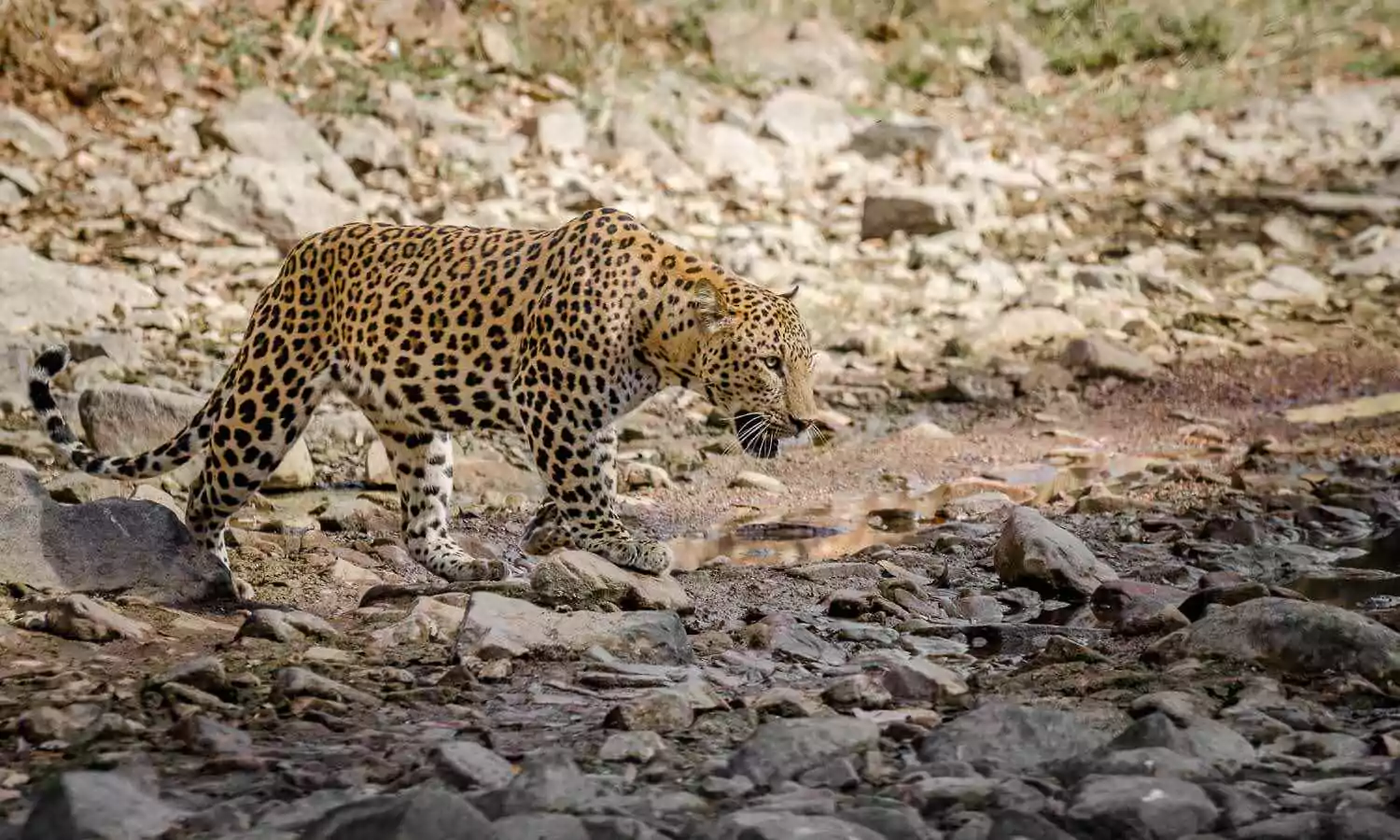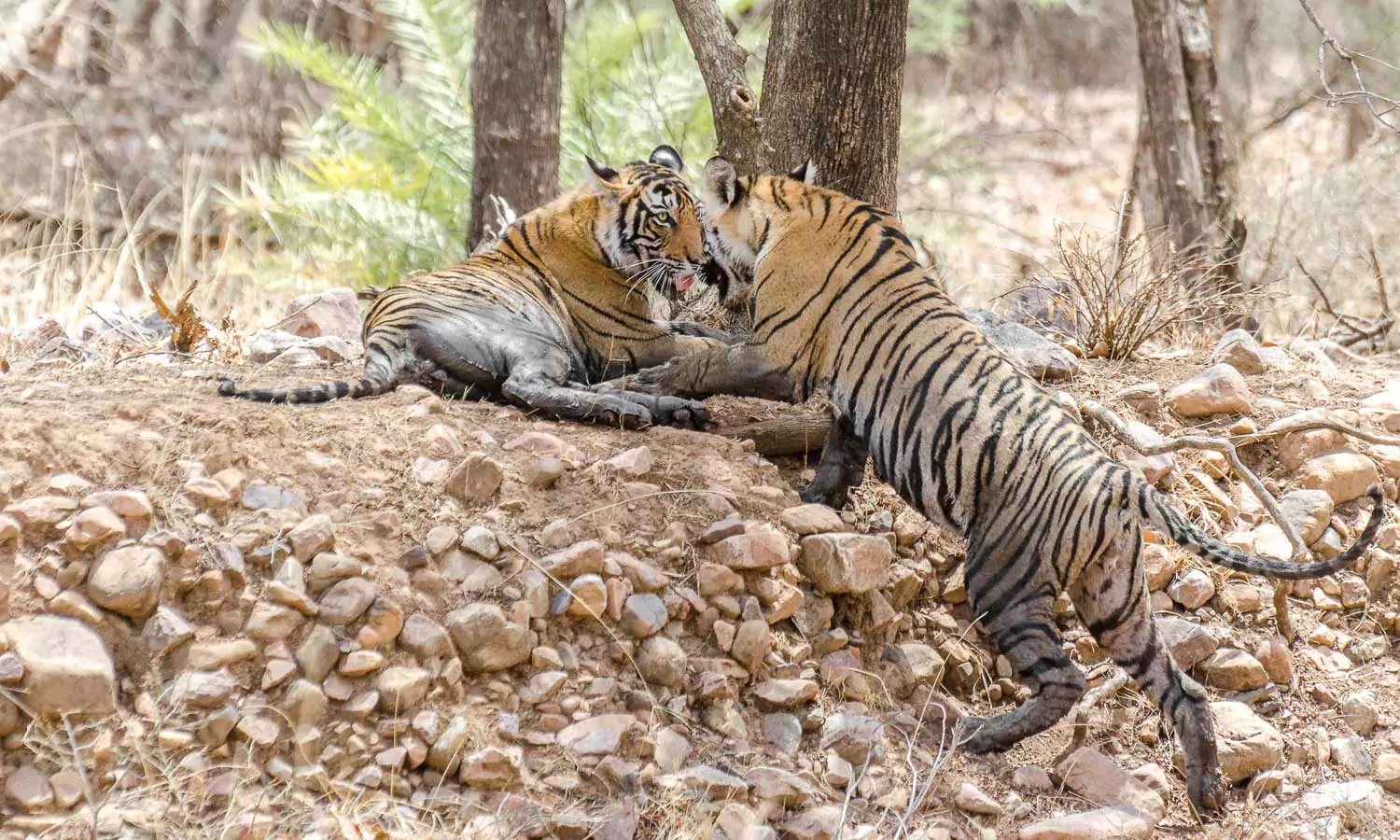Ranthambore National Park
Ranthambhore Tiger Reserve is the single largest expanse of dry deciduous Anogeissus pendula Forest left intact in India. It is home to over 40 species of mammals, 320 species of birds, over 40 species of reptiles and over 300 species of plants. Currently, it is home to 60 adult tigers & 20 cubs.
Situated in the desert state of Rajasthan, Ranthambore’s flagship species is Panthera Tigris Tigris- the Indian or the Bengal tiger. The forest remains dry for more than eight months in a year & therefore the chances of spotting this elusive big cat are much higher as compared to other tiger reserves in India.
Ranthambore Tiger Reserve, was previously a private & exclusive hunting reserve of the Jaipur royal family until 1955 when the forest was declared ‘Sawai Madhopur Sanctuary’. The practice of issuance of game permits finally came to an end in 1973 when this sanctuary was declared a part of Project Tiger, resulting in the relocation of 12 villages located inside the park. In 1980, to give greater protection to the forests, an area of 282.03 sq. km of the inner part of Sawai Madhopur Sanctuary was declared a national park. Since then, the state Government stopped the collection of any forest produce from sanctuaries and national parks. In the year 1983, 647 square km. of forests lying to the North of the National Park were declared as the Kaila Devi Sanctuary and included in the Tiger Project. Similarly, in 1984, 130 square km of forests lying to the South of the Ranthambore National Park were declared as Sawai Mansingh Sanctuary and included in the Tiger Project. Today, this Project tiger reserve spans over 1334 sq. km of area, of which 282 sq. km is the Ranthambore National Park.
The project tiger reserve is where the Aravali and the Vindhyan hill ranges meet and this confluence is perhaps the reason for the rich bio-diversity of the Ranthambore. The geological formations of the Vindhyan system are characterized by flat tabletops locally known as ‘Dang’, while sharp ridges and conical hilltops characterize the Aravallis. An important geological fault line – the Great Boundary Fault – lies at the confluence of the Aravali and the Vindhyan systems – and runs right across Ranthambore National Park.
Ranthambore National Park is dotted with structures that remind you of bygone eras. There are many water bodies located all over the park, which provide perfect relief during the extremely hot summer months for the forest inhabitants. A huge fort, after which the park is named, towers over the park atop a hill. There are many ruins of bygone eras scattered all over the jungle, which give it a unique, wonderful and mixed flavour of nature, history and wildlife. Tigers at Ranthambore National Park have been known to even hunt in full view of human visitors. These tigers are famous for being seen in the daytime too, due to their lack of fear of human presence in vehicles. This lack of fear of humans
Sighting at Ranthambhore
Ranthambore is a dry-deciduous forest, which means that there is little undergrowth and most of the trees shed their leave in the dry season. Out of all the tiger reserves in India, Ranthambore gets the least amount of rainfall and as a result, there are very few patches with tall grasses. Besides, this Project Tiger Reserve has an excellent network of forest tracks (that are motorable in the dry season).
All the above-mentioned factors contribute to some great wildlife viewing, during safaris. Since there is little undergrowth and very few patches with a tall and thick cover of grasses, the visibility is fantastic. The excellent network of forest tracks allows for much better tracking of animals from vehicles. Besides, most of the safari tracks in Ranthambore, are heavily used animal tracks that have been widened to enable safari vehicles to drive on them. As a result, a lot of mega-fauna can be seen on or very near the forest tracks.
This is particularly true for tigers. Tigers have very soft pads under their feet, which enables them to move silently – a very important adaptation for hunting. Due to this, they prefer to walk on the safari tracks, which have soft sand covering, very little thorns, rocks and dried leaves. Not only is it more comfortable for them when they are walking on the tracks but the soft sand and the relative absence of twigs and leaves enables them to walk silently, without alerting their prey.
Sighting tigers in the wild is a matter of chance but these chances can be improved considerably. Before going in for the safari it is important to have some knowledge of the movement of tigers in the park in the last few days. Most local guides and drivers (who are excellent at finding tigers) have this information. They mostly get this information from their observations in the last few days and from the observation of other guides and drivers. Once you know the movement patterns of tigers in the last few days then it is possible to predict the areas where the chances of finding tigers are better. For instance, if you know that a particular tiger has made a kill in a particular place, then the chances are that the tiger will be in the same area for the next 2 to 3 days. To know more about the movements of tigers, refer to the daily sightings update
Climate
Ranthambore has three very well-defined seasons – summers, winters and monsoons. October and March are the times when the weather changes from monsoons to winters and from winters to summers, respectively.
Summers start at the end of March and last through April, May and June. During this season the days are very hot and dry. During May and June, the maximum day temperature crosses 40 degrees Centigrade and the minimum night temperature still hovers around 30 degrees Centigrade. During the day, hot and dry winds. Most of the ungulates and the large predators spend the summer months in the valleys. The maximum day temperature often crosses 45 degrees C in May and June, when the relative humidity is at its lowest. The monsoons or the rainy season lasts from July to September.
The winter season lasts from November to February. The night temperature stays below 10 degrees Centigrade, while the day temperature hovers around the 20-degree Centigrade mark. There is often some rain and fog during the mid-winters. During December and January, the lowest nighttime temperature goes down to 2 degrees C.
Safari:
Safaris are conducted twice a day across 10 designated tourism zones in the park by the forest department. One can pre-book a 6-seater jeep or 20-seater open bus (cantor) for safari both use the same safari tracks on the designated route. Zones 1-6 are considered premium zones and are much in demand, a maximum of 50 vehicles are allowed in these zones. At any point in time, a maximum of 8 vehicles i.e. 3 gypsy and 5 cantors are allotted the same route.
Under the new facility provided by the forest department, one can prebook the safari route at the time of booking else get the same changed at the time of releasing the vehicle by paying an additional fee, subject to availability. Vehicles and guides are allocated on a roaster system. In case you wish to do safaris in the same vehicle and use the same guide you need to pay an additional fee of 6800/- and 1600/-per safari.
A normal safari shift lasts 3.30 hours and the time varies with change in season. Normally a safari begins half an hour post sunset & ends half an hour before sunset.
If the advance quota for jungle safari is already full in Ranthambore, one can opt for the Tatkal safari by paying an additional premium. The Tatkal quota is available for zones 1-6 and can only be booked 7 days prior. The cost of the Tatkal safari is 11000 per safari, which is for the entire vehicle and is over and above the normal safari costs.
Ranthambore Jungle Safari Timings
| Period | Morning | Evening |
|---|
| From 1st Oct to 31st Oct |
06:30 am - 10:00 am |
02:30 pm - 06:00 pm |
| From 1st Nov to 31st Jan |
07:00 am - 10:30 am |
02:00 pm - 05:30 pm |
| From 1st Feb to 31st Mar |
06:30 am - 10:00 am |
02:30 pm - 06:00 pm |
| From 1st April to 15th May |
06:00 am - 09:30 am |
03:00 pm - 06:30 pm |
| From 16th May to 30th June |
06:00 am - 09:30 am |
03:30 pm - 07:00 pm |
Ranthambore Fort is one of the six forts included in the World Heritage Site from Rajasthan. Situated within Ranthambore Tiger Reserve, the fort is known for the glory and valour of Hammir Dev of the Chauhan dynasty. Its earlier name was Ranastambh or Ranastambhapur.
The fortress of Ranthambore founded in 944 is considered the second largest fort in Rajasthan after Chittorgarh. Raja Sajraj Veer Singh Nagil (880 to 935 AD) was the first ruler of Ranthambore who developed and raised infrastructure to make this area suitable for defence. After the defeat of the Chauhan king Prithviraj Chauhan by Muhammad of Ghori in 1192, Ranthambore, led by Govinda Raja, son of Prithviraj, became the centre of Chauhan's resistance to the expanding Sultanate of Delhi. The fortress passed to the Kachwaha Maharajas of Jaipur in the 17th century, and it remained part of Jaipur state until Indian Independence.
Inside Ranthambore Fort, there are three Hindu temples dedicated to Ganesh, Shiva and Ramlala ji constructed in the 12th and 13th centuries from red Karauli stone. There is also a Jain temple of Lord Sumatinath (5th Jain Tirthankar) and Lord Sambhavnath
The famous Trinetra(three-eyed) Ganesh temple is believed to be the protector of Ranthambore forest & supposedly protects humans from wild animals. Every year more than 5 million people visit this temple out of which approximately 1 million visit the temple during Ganesh Mela celebrated around August-September every year.
Visitors are allowed to visit the fort between sunrise & sunset every day. If carrying own vehicle to the fort entry gate, one needs to have a valid PUC certificate. From the entry gate at Jogi Mahal, an easy walk of approximately 1.5 km would take you to the top of Ranthambore Fort.
Quick Facts:
- Area: 1334 square kilometers
- Latitudes: 25 46′N to 21 12′N
- Longitudes: 76 17′E to 77 13′E
- The nearest town and railway station: is Sawai Madhopur, 12 kilometres
- Nearest Airport: Jaipur approx 170 km
- AV. elevation: 350 meters M.S.L.
- Annual rainfall: 800 mm
- Geography: Two hill systems meet in the forest: the Aravali and the Vindhyan ranges.
In case you wish to seek more information or require booking assistance feel free to write to us
















